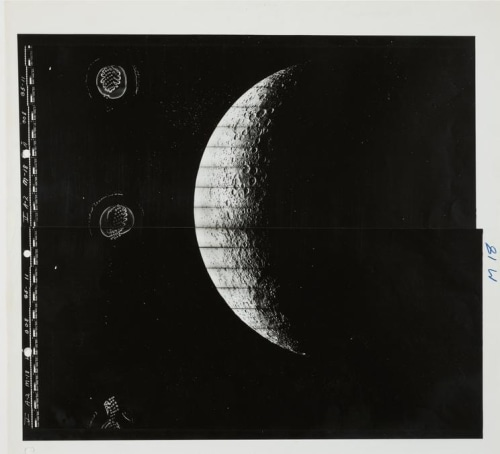



OPENING: THURSDAY, JUNE 9TH
6:00 - 9:00 PM
THE ORB:
MORTEN LØBNER ESPERSEN MOON VESSELS | NASA PHOTOGRAPHS FROM THE LUNAR ORBITER MISSIONS 1966-1967
Jason Jacques Gallery is pleased to present The Orb, an exhibition of Lunar Orbiter photographs taken of the Moon by NASA between 1966 and 1967, paired with ceramic vessels by contemporary Danish artist Morten Løbner Espersen.
Depicting the Moon from various angles and distances, the Lunar Orbiter photographs were captured over the course of five unmanned missions from 1966 through 1967, in a program designed to photograph and assess all potential landing sites for the Apollo mission. The photographs also aimed to provide baseline imagery for future geologic analysis of the lunar surface. The first mission remains famous for producing the first photograph of the Earth from the Moon, taken in August 1966.
Derived from negatives captured with an incredibly advanced imaging system, these vintage gelatin silver prints mapped 99 percent of the Moon’s surface in high-resolution. The first three missions successfully photographed potential landing sites, while the fourth and fifth covered the entire lunar nearside and farside of the satellite. The lunar orbiters used a complex imaging system that includes dual-lens camera, a film-processing unit, a readout scanner, and a film apparatus. The resulting rolls of 70mm film were then processed, scanned, and transmitted back to Earth.
Though an inherently scientific mission, the results of this Lunar Orbiter program are beautiful, haunting images of the glowing orb that hangs in our night sky. The varying shades of black and white and spectacular views of the lunar surface create eerie silent images of tremendous beauty, which magnificently picture the moon’s relief and its many craters. The photographs, upon their release, captivated audiences who, for the first time, saw detailed photographs of the surface of another body in space. They testify to the tremendous scientific and public interest in the moon and space in the 1960s, which culminated in the first manned moon landing of 1969.
Alongside the NASA photographs, Morten Løbner Espersen’s stoneware vessels, themselves named after the Moon, are a perfect complement to the black and white images. Spherical in silhouette and highly textured, Espersen’s Moon Vessels echo the appearance of the Moon in both shape and surface, craters and crevices lending the pieces a purposely irregular quality. Coated in shades of alternating vibrant and muted glaze, the Moon Vessels add a dimension of color to the black and white photographs, in an inspired interpretation of the same subject matter. Espersen’s Moon Vessels explore opposing principles, unifying simple oval forms with complex surfaces, which recall the volcanic surface of the pieces of Viennese sculptor Lucie Rie. Magnified by a unique satiny glaze that contrasts with the convoluted shapes of the sculptures, Espersen’s pieces constitute an exciting aesthetic challenge to the two-dimensional NASA photographs.
Set in Jason Jacques Gallery’s main exhibition room, the Orb Show is an adventurous pairing combining two starkly different portrayals of the Moon in a type of cosmic surrealism.
MORTEN LØBNER ESPERSEN
b. 1965, Denmark
Morten Løbner Espersen (1965 in Aalborg, Denmark) is one if the most successful Danish ceramists of his generation. Morten Løbner Espersen has brought a new energy to the tradition of ceramics through a 20-year exploration of his object of choice, the vessel. Based in Copenhagen, Espersen explores the simplicity of the form through variations of this archetype that balance opposing principles: simple form and complex surface, or complex shapes and simple surfaces. Whether his vessel is of modest, cylindrical nature or a chaotic, writhing mass of layered glazes, Espersen strives to create a quality in glazing comparable to Japonist pottery. Likened to the frothy, volcanic surfaces of Lucie Rie’s stoneware, the organic and protruding forms of Axel Salto’s “budding” vases, and a Patrick Nordstom brilliance in glazing, Espersen’s clay forms exercise the full potential of his self-imposed neutral starting point. He has had numerous major international exhibitions since graduating in 1992 and establishing his own studio. Espersen has been a professor at HDK Göteborg University in Sweden since 2005 as well as continuing to work in his own studio in Copenhagen.
IMPORTANT PRESS LINKS:
WIDEWALLS MAGAZINE
C FILE
